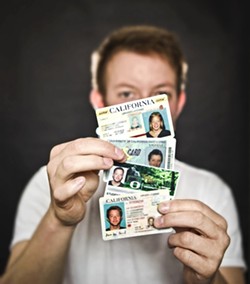The born identity: Why it's so important for transgender people to change their documents, and how it's now easier to do so
By Colin Rigley[
{
"name": "Promo Temp Targeted",
"id": "PromoTempTargeted",
"class": "inlineCenter",
"insertPoint": "4",
"component": "15511697",
"requiredCountToDisplay": "0"
},
{
"name": "Ad - Medium Rectangle CC01 - 300x250 - Inline Content",
"class": "inlineCenter",
"insertPoint": "8",
"component": "15582119",
"requiredCountToDisplay": "12"
},{
"name": "Ad - Medium Rectangle LC01 - 300x250 - Inline Content",
"class": "inlineCenter",
"insertPoint": "18",
"component": "15582122",
"requiredCountToDisplay": "22"
},{
"name": "Ad - Medium Rectangle 9 - 300x250 - Inline Content",
"class": "inlineCenter",
"insertPoint": "28",
"component": "15582121",
"requiredCountToDisplay": "32"
}]
The one thing Aaron has been asked about that most other people will never have to answer is the shape and condition of his genitals. It’s a question he clearly doesn’t like to answer, but it’s a question he’s been all but forced to answer almost any time he’s had to use any form of ID.
When he was going through airport security, he was pulled aside because the security scanner indicated he might be hiding something in his chest.
“Every time I flew I had to say, ‘Look, I have tits,’” Aaron explained.
When security staff patted him down, he had to deal with the humiliation of having a complete stranger draw attention to and touch a part of his body that didn’t feel like his body.
As best as he can explain it, before transitioning from female to male, Aaron felt like he was left handed (which he is), but was forced to use his right hand. Now that he’s transitioned—both medically and administratively through his identification documents—he said, “My overall mood and zest for life has increased dramatically, and I have felt at home in my body.”
Sitting in the outdoor patio of a café in San Luis Obispo, Aaron viewed the world through a pair of black sunglasses perched beneath a head topped by wispy blond hair. He’s a reserved, polite 26-year-old now hoping he’ll be accepted into a graduate degree program to pursue a career in speech pathology. With new documents in hand, he’s able to fill out the application papers with a name that reflects his identified gender.
It’s almost impossible to talk about someone like Aaron without falling headfirst into annoying clichés, repeating awkward situations and asking questions he’s had to answer for years, and skirting around topics about his deepest feelings of identity, his medical history, and how it’s all shaped him as a person. New Times has omitted his last name and former name out of an abundance of caution, because, unfortunately, people who don’t fit the gender norm are still targeted for backlash.
As Aaron tells it, the decision to make a transition to the gender he identifies with took about 15 years. So yes, he’s had the hormones and the surgery.
It also took about five months to make that transition on paperwork. And while that may seem less of a triumph, it’s huge.
During the interview for this story, he reached for his wallet and sprawled three ID cards on the table, each one depicting a photo that appeared increasingly feminine the further back in time it was taken. It wasn’t the first time he’s presented his old ID cards to talk about his gender.
Once, while trying to pay the bill at a restaurant, he had to pull out the cards to help explain why his most current ID said female when he very much appeared to be male. He found himself taking a complete stranger on a visual history of his gender transition, exposing one of the most private aspects of his life just so he could pay for some sushi.
“There was so much anxiety having to out myself every other day,” he said. “It was humiliating, and I shouldn’t have to explain myself.”
Not long ago, almost every time Aaron wanted to buy a drink or get on a plane, he would have to explain—with no guarantee for his safety—that he was, in fact, a man, even if his documents said otherwise. Any time he’s publicly outed in a situation outside of his control, there’s always the potential for danger, such as when he walked into the men’s restroom at a bar and a drunk man angrily confronted him.
“He was like, ‘Don’t come back to the bathroom until you grow a dick.’”
Aaron’s not alone. According to the National Transgender Discrimination Survey by the National Center for Transgender Equality and the National Gay and Lesbian Task Force, 40 percent of people who presented documents that didn’t match their identified gender reported harassment, while 3 percent reported being assaulted or attacked. Another 15 percent said they were asked to leave the establishment.
Perhaps unsurprisingly, the study found that discrimination against transgender people can vary based on economic, education, and racial factors. Multiracial respondents reported assault rates that were twice that (6 percent) of white respondents, while African Americans and Latinos were three times as likely (9 percent) to report being attacked or assaulted.
The problem is that changing a name or gender marker on documents like a driver’s license, birth certificate, and Social Security card can sometimes kick in an administrative procedure requiring that the person publish the change in a local paper. Typically, the requirement is meant to prevent fraud and debt ditchers. For a transgender change, however, it’s an unwanted advertisement.
“To be forced to publish your former name and your name change really does put many people potentially in harm’s way,” said Dru Levasseur, Transgender Rights Project director for Lambda Legal, an LGBT civil rights organization based in New York.
But a recently enacted law in California, Assembly Bill 1121, has made administratively minor but symbolically immense changes to ease the process for people who want their documents to reflect their identified gender.
The thing you start to realize when you talk to Aaron is that his story says much more about the world around him and how it treats gender identity than it does about his own transition. When he faced problems because of his ID, and when he tried to change that ID, he butted up against a culture that is very much tied to men being men, and women being women.
“This is a good law,” said Denise Taylor, a local doctor and member of the Tranz Central Coast steering committee. “This is something important for people to just do something that we all take for granted. You realize how many pieces of paper your name is on.”
Legislative transition
In 2013, California Assemblywoman and Assembly Speaker Toni Atkins introduced AB 1121, which was cosponsored by the San Francisco-based Transgender Law Center. Outside of a few LGBT publications and blogs, the bill has seemingly made few splashes in the media since it went into full effect in July of last year. Its language is hardly dramatic—the changes it instituted appear relatively unexciting as far as legislation goes—but its implications are big. It may also be the first of its kind in the country, though other states and the federal government continue to make strides in recognizing transgender rights.
“That’s just a wonderful move by California to recognize that requiring trans people to go to court and have an expensive court order, it doesn’t really make that accessible for people to have accurate documents,” Levasseur said.
AB 1121 made it easier, cheaper, and more private for Californians to change their gender markers on documents. The first phase of the new law went into effect Jan. 1, 2014, and removed the requirement that someone be forced to present a court order to change his or her gender on a birth certificate. Instead, anyone could take a physician’s note directly to the California Department of Public Health and pay a $23 fee to make the change.
In July of that year, the most significant aspect of AB 1121 went into effect and removed the requirement to publish a name and gender change in the local newspaper.
Ly-Lan Lofgren is a local social worker and sex therapist, as well as a member of the Tranz Central Coast Steering Committee. Gender identity and the very clear distinction between boys and girls are deeply ingrained in our culture, she said. And whether they intend to or not, parents can instill in their children a feeling that the best way to be loved is to repress any behaviors that might contradict biological gender.
“You have this life-long need to push down authentic expression of your gender,” Lofgren explained. “Then to have to publish it in a paper for two to four weeks, saying, ‘Here’s my name, here’s the town I live in, and I’m changing my name to something,’ it’s like putting a huge target on your house and saying to all of your worst nightmares, ‘Come find me.’”
Only 21 percent of people who already made the transition from one gender to another reported that they had updated all of their ID documents and records, according to the National Transgender Discrimination Survey.
Locally, Taylor said she’s written about 20 letters since AB 1121 went into effect. Before the law, she occasionally submitted letters for clients who wanted to change their gender marker on passports.
“Some people don’t even feel safe to socially transition ... until they have their identity cards,” she said.
Elsewhere in the country, bureaucracies have slowly been shifting to allow more people to more easily change documents. In 1977, the U.S. Department of Health and Human Services updated the Model State Vital Statistics Act, which was first put in place in 1907. The revision—one of five, according to a 2013 paper in the Michigan Journal of Gender and Law—“acknowledged that vital records should be corrected in the case of individuals who change their gender.” More so, it allowed the change to be kept private.
In 2010, the U.S. Department of State updated its policies and allowed a change of gender on passports without proof of sex reassignment surgery, as was previously on the books, instead requiring only a physician’s letter certifying that the person had transitioned to a new gender.
However, gender transition isn’t made easy in all parts of the country. There are 46 states that allow people to change gender on documents, according to the Michigan paper, but Oklahoma, Texas, and American Samoa don’t explicitly state that such a change is allowed. Tennessee explicitly prohibits residents from changing their gender documentation, and other places—including Idaho, Ohio, and Puerto Rico—don’t allow gender corrections.
Levasseur said Lambda Legal has gone to courtrooms around the country to educate judges and attorneys on transgender issues and demonstrate that “this is actually a person being who they truly are.” The group does this, because despite laws on the books and established policies, name and gender changes do not always go smoothly in court. He said there was one instance when a judge refused to sign a name-change order, but not outright deny it, which would have opened the door to an appeal. The judge cited religious reasons, Levasseur said.
Taylor, for example, sees transgender clients from as far south as Anaheim, as well as others who travel from such places as Fresno, Yosemite, and Mojave. Some of her patients reported being turned away by doctors in their area, or encountering doctors who simply had no clue how to handle someone who wants to change gender. One doctor simply said, “We don’t do that,” and walked out of the room.
“The prejudice is still alive and well out there,” Taylor said. “And fortunately in California, it’s not nearly as bad.”
But there can still be bureaucratic hiccups in implementing the new law.
Ironing out the kinks
One of the most annoying things for Aaron is when someone accuses him of being deceptive about his identity, or when he’s asked about his genitals. Mostly, it’s clear that the moments that really bug him are when he’s somehow pressured to prove his gender.
It took him more than a decade to begin making the medical transition, which also required going through puberty again when he started taking testosterone.
“It was exhilarating, but also really frustrating,” he said about that second puberty—frustrating for all the reasons that puberty sucks, especially when you’ve already gone through it and are about to start again at the age of 20; but exhilarating “because I was finally going through the puberty that I had wanted to.”
Aaron had always felt that he should have been born male. He went through phases as a child when he tried to express his masculinity, but stopped when he was accused of being a tomboy. At the age of 13 he tried again. In response, his classmates called him “it,” “shim,” and “dyke.” So he repressed.
“I put on this façade of being a female, and I played the part really well,” he said.
People treated him normally again; boys started paying attention. Under many traditional qualifiers, he was living the life most adolescents want.
“It worked well for a while, because I felt appreciated and loved for the body I had,” he said. “But it felt like a scam.”
The years of hiding his true identity resulted in suicidal thoughts. He turned to drugs and alcohol and fell into a depression because of the identity he’d kept hidden until attending a support group in college. It was then that he decided to make the transition again: this time with hormones, surgery, and a name change. And when AB 1121 passed, after he’d undergone a chest-reconstruction surgery, which he said was his first priority, he began the process of changing his identity on paper.
He had trouble finding people to help, and decided to navigate the process on his own (Aaron said he now recommends that anyone in a similar situation contact Tranz Central Coast or the Transgender Law Center).
Aaron said the staff at the SLO Superior Court Family Law Center were extremely courteous but less than experts on the new law. He was told repeatedly that he would have to publish in the paper, but knowing the law, he stayed firm and refused to do so.
When New Times called the Family Law Center and asked for information about a simultaneous name and gender change, the staffer who answered the phone was polite, but acknowledged that she was unfamiliar with the process and referred the call to her supervisor. The supervisor then directed New Times to online resources through the Judicial Branch of California, which explained the process and provided the appropriate forms.
Officials with Tranz Central Coast said that not all local officials are experts at handling transgender requests, but they’re getting better.
Court Executive Officer Susan Matherly said civil staff at the court pride themselves on treating every member of the public with respect, and no matter the request, “when we’re processing these forms, we don’t ask too many questions.
Doug Heumann, a local attorney and secretary of the Tranz Central Coast Steering Committee and a member of the Leadership Council of the Transgender Law Center, agreed that local staff mean well, but steering through the system can sometimes be clunky for someone seeking a change. One local client ended up having to publish in the paper after mistakenly filling out the wrong form, Heumann said.
Nationally, the requirement to show proof of a gender change surgery is waning in favor of physicians’ notes. But during his visit to the local Social Security office, Aaron said, the clerk repeatedly asked if he had proof of “the surgery,” without specifying further. He argued that he didn’t have to show proof, and she eventually withdrew and processed his paperwork.
Aaron still has many of his old documents in his wallet, but he no longer has to use them. When someone asks to see his ID, he won’t have to worry that the paper says female while his face says male.
“If I could go back and talk to myself 20 years ago, I would have said, ‘What the hell are you waiting for? Why have you waited so long to do this?’” he said. “I would have said, ‘Just go for it.’”
The difference now is that going for it is easier. While Aaron said he’s annoyed when people hassle him about his gender identity, it’s as annoying when they’re overly positive and shower him with flattery.
“I know why it irks me, because the alternative was killing myself,” he said. “Yeah, I was brave to take the steps necessary to become my more authentic self, but it wasn’t like I had a choice.”
Contact Senior Staff Writer Colin Rigley at [email protected].
Latest in News
Readers also liked…
-

SLO police identify alleged driver who hit and killed couple
Dec 22, 2022 -

When the levee breaks: Oceano residents, county officials walk a tightrope of regulations to manage Arroyo Grande Creek, which some say led to the levee's failure in January
May 18, 2023 -

Cal Poly report highlights offshore wind's potential to spur green energy transition
Jun 8, 2023









